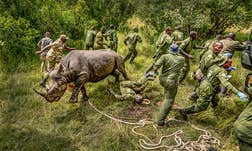We humans tend to flock to natural spaces in search of peace and quiet. But paradoxically, what we often bring with us when head into the woods or the mountains is noise: The shuffle of feet or whir of bicycle wheels, the trampling of branches and the cacophony of conversation.
Now a new study suggests this noise can have a lasting impact on wildlife. The findings, published in the journal Current Biology, contribute to a debate about the way some nature conservation areas are set up today. They tend to serve dual purposes that may not always be compatible: protecting shrinking wildlife habitat and providing recreation spaces for humans.
“There’s an increasing trend of people wanting to go farther and deeper into the woods and in more places,” says Mark Ditmer, a United States Forest Service ecologist and study co-author. “And researchers are just starting to understand the impacts.”
Groups of hikers and mountain bikers were most likely to cause animals to flee.
Human recreation has already been linked with trouble for wildlife in the form of increases in stress hormones, changes in habitat, and fewer offspring. But the authors of the new study wanted to understand more precisely how noise fits into this picture, and how different outdoor activities and group sizes impact animals.
To explore this question, the team wired up a system of wildlife cameras and speakers on trails throughout Wyoming’s Bridger-Teton National Forest, which dominates the Greater Yellowstone Ecosystem. Known for its limestone cliffs, crystal clear rivers, and abundant wildlife, the forest has played a critical role in the recovery of species such as the wolf, grizzly bear, and white bark pine.
The creatures the research team captured on camera included mule deer, elk, red foxes, black bears, moose, pronghorns, cougars, coyotes, and wolves. When the animals ambled into the study areas, the scientists triggered speakers to broadcast different types of noise, while the cameras filmed the animals’ responses to the sounds. The recorded noises included sounds associated with hiking, trail running, mountain biking, and off-road vehicles, and some of them featured human voices, as well. As controls, the team used recordings of ambient natural sounds and no noise.
When the animals heard human recreation noise, they were two to three times more likely to flee an area—considered an anti-predator response—than when they heard natural sounds or no noise. The loudest recreation noise seemed to scare away wildlife the most, regardless of what kind of recreation it was, but group size and talkativeness also played an important part. The sounds of large groups of hikers and mountain bikers were most likely to cause animals to bolt.
The findings can help public lands managers make decisions about how to manage conservation areas, says Kathy Zeller, a U.S. Forest Service biologist who led the study. “If there’s critical habitat for species over here, maybe they want to build trails in another area, or limit things like group size or recreation type,” says Zeller.
To determine whether the noise impacts were lasting, the researchers also measured the relative abundance of wildlife in a study area a week and a half after a noise broadcast. They found that after an average of just 1.7 simulated recreation events per day, the abundance of wild animals in a particular area was still lower more than a week later. “It was surprising to see the strength of the response—after the equivalent of one or two groups using a trail a day,” says Zeller. For reference, the national forest in the study receives some 3.6 million visitors every year.

Not all animals behaved the same way in response to noise. Elk were the most sensitive, mule deer were moderately sensitive, while predators such as mountain lions were the least sensitive—in some cases, the predators even approached the speakers to investigate. In the future, the team of scientists wants to study whether and to what extent wildlife may habituate to human-generated sounds over time.
The findings make “a lot of intuitive sense,” says Liana Zanette, a biologist at Western University in Ontario, Canada. Last year Zanette and colleagues found that 19 species of African savannah mammal were more likely to flee when they heard broadcasts of human sounds than when they heard broadcast sounds of any other animal found on the savannah, including the most fearsome predator, the lion. “Humans make a lot of noise; it can be soft, it can be loud, but it all adds up to noise,” says Zanette. “The louder and longer it is, the more frightened wildlife are of it.”
Separating humans and wildlife isn’t the only solution, says Zeller. An experiment from 2011 at Muir Woods National Monument in California, showed that signs can have an impact—visitor noise levels dropped significantly after researchers placed signs that read “Quiet Zone,” or “Quiet Day,” and the number of birds tallied in the designated area later increased. According to visitor surveys, when they embraced the silence, people “found themselves listening to more birds and enjoying nature more,” says Zeller. It also allowed park managers to increase the number of people who could use a given trail.
When humans are made aware of their impacts—even in the realm of something as seemingly innocuous as sound—they can change their behavior, and that can impact wildlife. “We simply do not often think of ourselves as a major predator of wildlife, let alone the most dangerous, but wildlife clearly think differently,” says Zanette, “and recognize us for what we are.” ![]()
Lead photo by Rocky Mountain Research Station, U.S. Forest Service




























